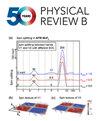Pb-intercalated epitaxial graphene on SiC: Full insight into band structure and orbital character of interlayer Pb, and charge transfer into graphene
IF 3.7
2区 物理与天体物理
Q1 Physics and Astronomy
引用次数: 0
Abstract
Intercalation is a robust approach for modulating the properties of epitaxial graphene on SiC and stabilizing two-dimensional intercalant layers at the graphene/SiC interface. In this paper, we present synchrotron-based angle resolved photoelectron spectroscopy (ARPES) measurements focusing on the band structure of intercalated Pb under a single layer of epitaxial graphene. The interlayer Pb exhibits a metallic character, a (1×1) registry with respect to SiC, and free-electron-like bands to first order. Divergences from the free-electron approximation include various band splittings and gaps throughout the Pb Brillouin zone. Light polarization-dependent ARPES measurements indicate a predominant out-of-plane orbital character for the Pb bands, suggesting potential interactions between the interlayer Pb and graphene'sSiC上嵌入Pb外延石墨烯:全面了解层间Pb的能带结构和轨道特性,以及电荷向石墨烯的转移
插层是调节碳化硅上外延石墨烯特性并在石墨烯/碳化硅界面稳定二维插层的一种有效方法。本文介绍了基于同步辐射的角度分辨光电子能谱 (ARPES) 测量,重点研究了单层外延石墨烯下插层铅的能带结构。层间铅表现出金属特性、相对于碳化硅的 (1×1) 重排和一阶自由电子样带。与自由电子近似的偏差包括整个铅布里渊区的各种带分裂和间隙。与光偏振相关的 ARPES 测量结果表明,铅带主要具有平面外轨道特性,这表明层间铅和石墨烯 π 轨道之间存在潜在的相互作用,可能会诱发石墨烯中的邻近效应。对 SiC 上 (1×1) 铅单层进行的密度泛函理论计算显示,实验观察到的层间带与偏振相关测量结果在质量上有合理的一致性。最后,随温度变化的 ARPES 测量显示,近乎电荷中性的石墨烯层涉及来自层间铅和基底碳化硅的电荷转移。 美国物理学会发表于 2025 年
本文章由计算机程序翻译,如有差异,请以英文原文为准。
求助全文
约1分钟内获得全文
求助全文
来源期刊

Physical Review B
物理-物理:凝聚态物理
CiteScore
6.70
自引率
32.40%
发文量
0
审稿时长
3.0 months
期刊介绍:
Physical Review B (PRB) is the world’s largest dedicated physics journal, publishing approximately 100 new, high-quality papers each week. The most highly cited journal in condensed matter physics, PRB provides outstanding depth and breadth of coverage, combined with unrivaled context and background for ongoing research by scientists worldwide.
PRB covers the full range of condensed matter, materials physics, and related subfields, including:
-Structure and phase transitions
-Ferroelectrics and multiferroics
-Disordered systems and alloys
-Magnetism
-Superconductivity
-Electronic structure, photonics, and metamaterials
-Semiconductors and mesoscopic systems
-Surfaces, nanoscience, and two-dimensional materials
-Topological states of matter
 求助内容:
求助内容: 应助结果提醒方式:
应助结果提醒方式:


